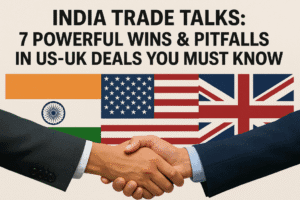India Trade Talks: 7 Powerful Wins & Pitfalls in US-UK Deals You Must Know
India is advancing high-stakes trade talks with the US and UK, aiming to secure interim deals that address tariffs, non-tariff barriers, and services. A 90-day roadmap with the US prioritizes “rules of origin” to prevent Chinese goods from bypassing tariffs via third countries, a lesson from the Trump-era trade war. Washington seeks greater access for agricultural exports and automobiles, while India pushes back on data localization demands to protect digital sovereignty.
Simultaneously, UK negotiations focus on reducing duties for Scotch whisky and easing mobility for Indian professionals. These efforts align with India’s strategy to counterbalance China’s influence and attract supply chains diversifying from East Asia. Challenges remain in shielding domestic sectors like agriculture and small industries, even as global trade fractures drive urgency. The outcomes could reshape India’s economic partnerships, blending strategic geopolitics with pragmatic concessions.

India Trade Talks: 7 Powerful Wins & Pitfalls in US-UK Deals You Must Know
As global trade dynamics grow increasingly fractured, India is fast-tracking negotiations with Western partners to secure strategic agreements. A high-stakes three-day visit by Indian negotiators to Washington, starting April 23, aims to finalize a 90-day roadmap for an interim trade deal with the U.S., while Commerce Minister Piyush Goyal prepares to resolve lingering disputes with the UK. Here’s a breakdown of what’s at stake and why these talks matter.
The U.S.-India “90-Day Roadmap”: What’s on the Table?
The interim deal focuses on 19 chapters covering tariffs, non-tariff barriers (NTBs), services, and rules of origin—a critical sticking point. Rules of origin prevent third-party nations (like China) from rerouting goods through partner countries to bypass tariffs. This became a major issue during the Trump-era U.S.-China trade war, where Chinese products entered the U.S. via Vietnam and Mexico, undermining tariff effectiveness.
For India, similar concerns exist with ASEAN nations, where Chinese goods often exploit free trade concessions. Tightening these rules could protect both economies from being flooded with indirectly sourced Chinese products.
Key Demands:
- U.S. Priorities: Reduced Indian tariffs on automobiles, whisky, and agricultural imports. Washington seeks greater access to India’s agriculture sector, though India may negotiate quotas to shield domestic farmers.
- India’s Asks: Addressing NTBs on pharmaceuticals, IT services, and mobility for skilled professionals.
Digital Trade Tensions:
The U.S. is expected to challenge India’s data localization laws, which mandate companies like Visa and Mastercard to store user data domestically. This clash mirrors past friction during Trump’s tenure and could test India’s balancing act between data sovereignty and foreign investment.
Why Timing Matters
The U.S.-China trade war’s escalation has spurred both powers to forge new alliances. While the U.S. courts India, Japan, and South Korea, China is deepening ties with Vietnam, Malaysia, and Cambodia. India’s push for an interim deal aligns with the Biden administration’s 90-day “tariff pause” window, offering a temporary truce to negotiate broader terms.
Industry Pressure:
Indian steelmakers warn of $5 billion in losses due to tariff uncertainty, while IT firms report dampened Q4 earnings as U.S. clients curb spending. Federal Reserve Chair Jerome Powell notes that shifting trade policies may inflame inflation and delay investments—a risk both nations aim to mitigate.
UK Talks: Whisky, Mobility, and the Final Hurdles
Parallel negotiations with the UK are nearing completion, focusing on:
- Tariff Reductions: UK seeks lower duties on Scotch whisky and automobiles.
- Professional Mobility: Easier visa access for Indian workers in exchange for UK services market access.
- Sustainability Clauses: Potential inclusion of labor and environmental standards, contentious for India’s SME sector.
The Geopolitical Chessboard
India’s dual-track negotiations underscore its strategy to diversify trade partnerships amid U.S.-China rivalry. A deal with Western economies could:
- Boost Export Competitiveness: By easing market access for Indian pharmaceuticals, textiles, and IT services.
- Counterbalance China: Strengthening ties with the U.S. and UK aligns with India’s broader Indo-Pacific ambitions.
- Attract Supply Chains: As companies shift production from China, clear trade terms could position India as a manufacturing alternative.
Challenges Ahead
- Agriculture Sensitivity: India’s farm sector, employing nearly 40% of its workforce, remains a political minefield. Concessions to the U.S. must balance rural interests with trade gains.
- Digital Sovereignty: Relenting on data localization could spark domestic backlash, despite pressure from U.S. tech giants.
- Tariff Trade-offs: Reducing duties on luxury goods (like whisky) may dent local industries but could secure wins in services.
The Road Ahead
While an interim U.S.-India deal seems achievable within 90 days, a comprehensive agreement hinges on resolving deeper issues like agricultural subsidies and digital governance. For the UK, closing the deal before its 2025 election cycle is crucial to showcase post-Brexit wins.
As negotiations unfold, India’s ability to navigate these complexities will shape its role in a fragmented global economy—where trade is no longer just about commerce, but geopolitical alignment.
You must be logged in to post a comment.